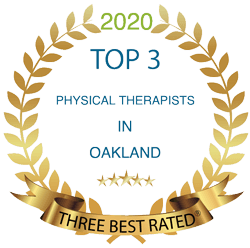If you have pain around the kneecap that doesn’t go away or gets worse with activity, you may have runner’s knee. The name is misleading, as anyone can experience it, not only runners. The good news is that physical therapy can be beneficial in treating runner’s knee.
Understanding the signs, causes, and treatments available for runner’s knee is crucial for managing this condition. This article will explain what runner’s knee is and how physical therapy can help alleviate the pain associated with this common condition.
What is Runner’s Knee?
Runner’s knee, also known as patellofemoral pain syndrome (PFPS), is a condition characterized by pain around the kneecap. It can be caused by various conditions and injuries and is often aggravated by activities like running, squatting, or climbing stairs.
Your kneecap (patella) is found over the front of your knee joint (patellofemoral joint). The kneecap is attached to your shin bone and thigh muscles by ligaments and tendons. When you bend your knee, the back of your kneecap slides across the cartilage of your thighbone (femur). If there are abnormalities in any of these moving parts, you experience patellofemoral pain.
Symptoms of Runner’s Knee
Symptoms of runner’s knee can include:
- A dull, aching pain around the kneecap during or after physical activity
- Pain that is aggravated by activities such as running, squatting, jumping, or sitting with bent knees for an extended period of time
- Popping or grinding in the knee joint
- Tenderness or swelling around the kneecap
- Difficulty fully straightening the knee
These symptoms can also be caused by other conditions, such as arthritis and ligament tears. Discussing your symptoms with your medical provider is essential, as treatment varies depending on the condition.
Causes of Runner’s Knee
Knowing the cause of runner’s knee can help your physical therapist determine the most effective treatment plan. Some risk factors and causes of runner’s knee include the following.
- Excess weight gain adds additional stress to the knees, increasing the risk of pain.
- If bones from the hips to the ankles are malalighted, the kneecap can shift.
- Chondromalacia patella occurs when the cartilage under the kneecap softens and then deteriorates, causing inflammation and pain.
- Overuse of the knee can lead to knee pain.
- Improper training or overtraining without sufficient recovery time can stress and damage the knee.
- Tight thigh, calf, and outer thigh muscles and hamstrings can increase knee pain.
- Trauma to the ankle, knee, or hip can change the biomechanics of the knee, resulting in stress on the knee joint.
- The knee joint can experience an additional stress burden during activity if the hip and/or thigh muscles are weak or lack movement control.
- Issues with the feet, such as fallen arches or overpronation, can impact the alignment of the knee joint and increase pain.
How Physical Therapy Helps Runner’s Knee
Physical therapy plays a crucial role in managing runner’s knee by reducing pain, improving knee function, and addressing underlying biomechanical issues. Here are some of the benefits of physical therapy on runner’s knee.
- Pain Management—Modalities such as ultrasound, electrical stimulation, dry needling, and ice therapy can help reduce inflammation and alleviate pain in the knee joint.
- Strengthening Exercises — Strengthening exercises for the quadriceps, hamstrings, and hip muscles can correct muscle imbalances and improve knee stability. These exercises can include squats, lunges, leg presses, and hip abduction movements.
- Stretching and Flexibility —Stretching tight muscles, such as the quadriceps, hamstrings, and iliotibial (IT) band, can improve flexibility and restore normal joint mechanics. To release tightness in soft tissues, foam rolling and manual therapy techniques may be used.
- Biomechanical Assessment — A comprehensive biomechanical assessment can help identify structural abnormalities and movement patterns that could contribute to runner’s knee. Your physical therapist can recommend exercises and gait retraining techniques to improve movement efficiency and reduce stress on the knee.
- Activity Modification — Your physical therapist can guide you in modifying activities that can reduce the risk of aggravated symptoms. This can involve adjusting how far you run, incorporating cross-training activities, or using orthotic devices for additional stability and support.
- Home Exercise Program —You can manage runner’s knee in the long term by learning proper running mechanics, selecting proper footwear, and preventing further injury. Your physical therapist can also provide a personalized home exercise program to reinforce treatment effects and promote continuous self-management.
Preventing Runner’s Knee
After you’re feeling better, there are some steps you can take to avoid further knee joint pain. To start, don’t get back into intense exercise too quickly. Ease back into your workouts. You should be able to stand, straighten your knee, jog, and walk without pain. Make sure to have a good warmup, stretch, and wear supportive shoes to reduce the risk of pain and other injuries.
Let UpSlope Physical Therapy Help You Get Rid of Knee Pain
Runner’s knee can significantly impact one’s ability to participate in physical activities and lead an active lifestyle. However, understanding this condition and how physical therapy can effectively manage it can prevent future recurrences. Remember that early intervention and proactively managing this condition are essential to achieving optimal outcomes and getting back to pain-free activities.
At UpSlope Physical Therapy, we focus on solving the problems keeping our clients from doing what they love. When you choose our team to help you meet your physical therapy goals, you will get one hour of high-quality, individualized care from your designated doctor of physical therapy. You will never be treated by a rehab aid or assistant.
Contact us today and start living the high-performance, pain-free life you deserve.




